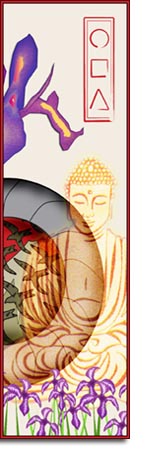On The Way: The Daily Zen Journal
The Essential Secrets for Entering the Way
Torei (1721-1792)
In what the Zen school calls ascending directly from the state of an ordinary person to Buddha, there are five discriminations: one is the meaning of same nature, second, the meaning of different paths, third, the meaning of urgency, fourth, the meaning of progressive practice, and fifth is the meaning of returning to the basis. This is the essential road.
First, same nature: the fundamental nature inherent in sentient beings is none other than the fundamental nature of all buddhas of the past, present, and future. Their range of powers and qualities are also equal, their lights are radiant; their knowledge, wisdom, and miraculous powers are all the same. This may be likened to the light rays of the great solar disc shining everywhere on the mountains, rivers, and plains; with this light all are illuminated.
Second, different paths: although in their fundamental nature buddhas and sentient beings are the same substance, no different, the directions of their minds are different. Buddhas shine inwards to illumine the basic mind, whereas sentient beings turn outward and get involved with myriad things.
That is why sentient beings create greed and lust for things they desire, anger and rage towards people they dislike, and become fools by becoming congealed in their thoughts; confused and stupefied by these three poisons, they have lost their very fundamental mind.
If you want to be free from this world of suffering, first you must contemplate impermanence. Those who are born must inevitably die. Even the young are not exempt; even the strong are in danger. Even the rich and prosperous decline, even the noble and exalted cannot remain that way. A long life does not last more than eighty years or so. Thus, this world being impermanent, there is nothing of lasting enjoyment.
The poor suffer from lack, the rich suffer from possessions, the high suffer from their high status, the low suffer from their low status; they suffer over food and clothing, suffer over families.
If you don’t annihilate the nature of afflictions somehow and arrive on the path of liberation, even if you ascend to the rank of sovereign of a nation, spirit, or wizard, it is still evanescent as lightning and morning dew, lasting only for a while.
Contemplating these four transcendences: impermanence, suffering, emptiness, selflessness, is called “the teaching of four realities, for disciples.” This is the essential gateway to beginning entry into the way for all enlightened ones.
The only thing worthy of prayer and trust is enlightenment; the only thing to be sought is the actualization of buddhahood. This body is a skin bag of habitual obstructions produced by the twelve-fold routine of conditioning.
First you must break through the root of ignorance; once the root is broken, the branches and leaves cannot remain. Practice generosity with goods and teaching, according to your means. Keep the Buddha’s precepts; tolerate people and don’t become angry. If you have free time, sit in meditation. When you hear the true teaching, consciously break through illusion.
Third, the sense of urgency means that if you want to realize the same nature of all buddhas, first you must clearly understand the root of ignorance. This is done by questioning your own fundamental nature. How to do this? Seeing  colors with the eyes, hearing sounds with the ears, feeling cool and hot with the body, discerning pleasant from unpleasant in the mind. These are the seeds of practice. Ordinary people get confused by form when they see it, confused by sound when they hear it, etc; this is what I call “sentient beings turning outward.”
colors with the eyes, hearing sounds with the ears, feeling cool and hot with the body, discerning pleasant from unpleasant in the mind. These are the seeds of practice. Ordinary people get confused by form when they see it, confused by sound when they hear it, etc; this is what I call “sentient beings turning outward.”
As for the practice of bodhisattvas, when they see forms, they question what it is that sees; when they hear, they question what hears, when they feel, they question what feels. This is what I call the “buddhas turning inward.”
When you practice like this, your orientation is different from that of ordinary people, as mentioned before. It is the same orientation of the buddhas, and, even if you don’t fully realize their wisdom and powers, you should realize that a fledgling bodhisattva has entered the intermediate state.
When you get up in the morning, no matter how hurried you are, first arouse this one thought by turning the attention inward; try this meditation work in seeing and hearing, and after that go about your business. When you eat, make this thought first and try this meditation.
When the day is over and you are going to bed, first sit awhile in bed with this thought foremost; try this meditation before lying down to sleep. This is the practice of the true and straight road of the buddhas and bodhisattvas.
Disturbed by the fact that you have lost the original nature which is the same substance as all the buddhas, turn to your fundamental nature and urge on your meditation efforts. This is called “the sense of urgency.”
Fourth, the meaning of progressive practice means that as you urge on your meditation on the fundamental as just described, you should progress moment after moment, practicing in everything.
Summoning forth the state of correct mindfulness in meditation, when you walk, you practice while walking, when speaking with people, you practice while speaking, and when silent and quiet, you urge on your correct mindfulness all the more.
When seeing things, ask who or what is it that sees; when hearing things, ask who is it that hears; when things are busy and it’s easy to get distracted, ask who is it that is distracted. Then even when distracted, you do not lose the right mindfulness of your meditation effort.
Fifth, the meaning of returning to the basis; as the work previously described progresses and your practice becomes wholly mature, eventually you return to the nature of the same one substance of all the buddhas. This is called fulfilling buddhahood.
Sometimes the mind is still. There is no anxiety, and the heart is clear throughout. Then it is said that even though the body is in the human realm, the mind roams in heaven. However in one day an ordinary person transmigrates countless times, during which he rarely keeps the human mind, much less roams in heaven.
Seeing reality and realizing the path is the crowning meditation of buddhas; those who set their minds on this are direct children of Buddha. In every moment of consciousness they carry out un-excelled practice of virtue; with every step they reach the ineffable action of transcendent wisdom. As far as wisdom is concerned, even the merit of reading or reciting words of wisdom is great; how much more so to carry them out!
This is called “the most worthy and most eminent, the foremost teaching”; it should be practiced to the best of one’s ability.
Torei Enji (1721-1792)
Excerptef from The Original Face: An Anthology of Rinzai Zen-Translated by Thomas Cleary




Careful reading of Torei’s teaching leaves us with the kernel of koan practice. In this case it is not the books of formal koans copied and memorized by so many students of Zen; but this is the original question asked on a very personal level. Who is it that is writing this? Who or what is it that is reading this? Essentially, Who am I? What is it that is dragging this body around?
A powerful pathway into enlightenment, and the constancy that Torei suggests we practice this is much more pervasive than the time spent on a cushion meditating. It becomes the eternal questioning of life which takes us to the inward turning of our awareness.
How many of us have the steadfastness for true practice? It takes a kind of virya or strength to stay true to one’s path over time. A lifetime of practice, sometimes alone, sometimes in the company of others, transforms the time spent here to a path of conscious evolution.
Inwardly Turned,
Elana, Scribe for Daily Zen